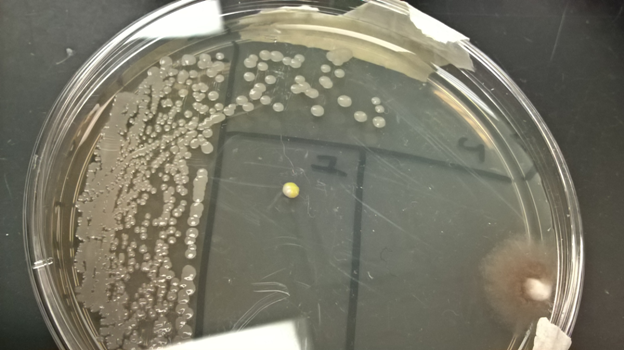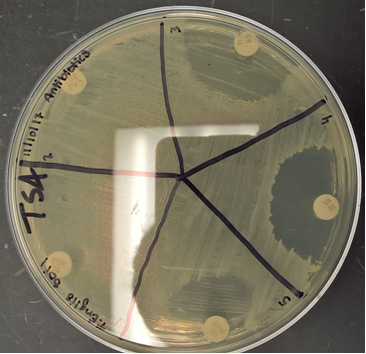Soil Project- English/Ramos: Difference between revisions
m (→Classification) |
m (→Species) |
||
| Line 10: | Line 10: | ||
Fictibacillus sp | Fictibacillus sp | ||
''Genus species'' | |||
Classification | |||
Bacillus Arsenicus also known as Fictibacillus arsenicus | |||
{| | {| | ||
| Line 15: | Line 20: | ||
'''NCBI: [http://www.ncbi.nlm.nih.gov/Taxonomy/Browser/wwwtax.cgi?mode=Tree&id=2&lvl=3&lin=f&keep=1&srchmode=1&unlock Taxonomy]''' | '''NCBI: [http://www.ncbi.nlm.nih.gov/Taxonomy/Browser/wwwtax.cgi?mode=Tree&id=2&lvl=3&lin=f&keep=1&srchmode=1&unlock Taxonomy]''' | ||
|} | |} | ||
==Habitat Information == | ==Habitat Information == | ||
Revision as of 19:22, 8 December 2017
Classification
Phylum: Firmicutes Genus: Bacillus Order: Bacillales Species: B. arsenicus
Species
Fictibacillus sp
Genus species
Classification
Bacillus Arsenicus also known as Fictibacillus arsenicus
|
NCBI: Taxonomy |
Habitat Information
Describe the location and conditions under which the organism was isolated. Collection Date: September 7, 2017 Air Temp: 76% Humidity: 36% 24Hr Rainfall: 0.00 Pressure: 30.03” Solar Radiation: 22.53 Depth of collection: surface to 1 inch deep Grid Coordinates: Lat 29.9425576 Long -98.4037259 Sample Location: In front of house right next to brick of house. Soil is noted to have large amounts of rocks.
Description and Significance
Describe the appearance (colonial and cellular), possible antimicrobial activity etc. of the organism, and why the organism might be significant.
Colony Morphology
Margin: Smooth Elevation: convex Surface: smooth Color: very light green Soluble Pigment: opaque
Cellular morphology:
Gram positive rods in long chains.
Possible microbial activity: The soil microorganism had antibiotic activity when we performed the mixed culture on an LB culture with a lawn of E. coli; there was clearing around the soil microorganism demonstrating antibiotic activity against E. coli.
Significance
Has nematicidal capability against root-knot nematodes and free-living nematodes. Essentially is it is toxic to nematodes. Arsenic resistant bacterium
Genome Structure
Describe the size and content of the genome. How many chromosomes? Circular or linear? Other interesting features? What is known about its sequence?
The soil microorganism was sent to a lab for sequencing and this was the result: AGACCTGGTAAGGTTCTTCGCGTTGCTTCNAATTAAACCACATGCTCCACTGCTTGTGCGGGCCCCCGTCAATTCC TTTGAGTTTCAACCTTGCGGTCGTACTCCCCAGGCGGAGTGCTTAATGTGTTAACTTCAGCACTGAGGGTGGAACCCCCC AACACCTAGNACTCATCGTTTACGGCGTGGACTACCAGGGTATCTAATCCTGTTTGCACCCCACGCTTTCGCGCCTCAGC GTCAGTTACAGGCCAAAAAGCCGCCTTCGCCACTGGTGTTCCTCCACATCTCTACGCATTTCACCGCTACACGTGGAATT CCACTTTTCTCTCCTGCACTCAAGTCTCCCAGTTTCCAATGACCCTCCACGGTTGAGCCGTGGGCTTTCACATCAGACTT AGGAGACCGCCTGCGCGCGCTTTACGCCCAATAATTCCNGATAACGCTTGCCACCTACGTATTACCGCGGCTGCTGGCAC GTAGTTAACCGTGGCTTTCTGGTTANGTACCGTCAAGGTACNAGCANTTACTCTCGTACTTGTTTCTTCTCTAACAA
Include S Ribosomal sequence that you obtained from PCR and sequencing here.
Unable to obtain from the lab; instead entered the sequence in the web site DNA BLAST and obtained this result:
Select seq KM598247.1 Fictibacillus sp. THG-SQK1 16S ribosomal RNA gene, partial sequence
RID
2NMY0NWT015 (Expires on 12-10 01:02 am)
Query ID
lcl|Query_140973
Description
None
Molecule type
nucleic acid
Query Length
553
Database Name
nr
Description
Nucleotide collection (nt) Program
BLASTN 2.7.1+
Cell Structure, Metabolism and Life Cycle
Interesting features of cell structure; how it gains energy; what important molecules it produces.
Scanning electron micrographs of the surface of a spheroidal concretion, a comparison of the lipid composition of B. arsenicus sp. nov. and B. barbaricus, and a neighbour-joining tree showing the phylogenetic relationships between B. arsenicus sp. nov. and other species of the genus Bacillus.
The soil microorganism did not show motility on the tests we performed, although in our research the microorganism is described as motile. After one week of being cultured on an LB plate, we did not see endospore formation; this occurred probably because it was too soon to see endospore formation. On our research there is evidence of endospore formation.
Physiology and Pathogenesis
Biochemical characteristics, enzymes made, other characteristics that may be used to identify the organism; contributions to environment (if any).
If relevant, how does this organism cause disease? Human, animal, plant hosts? Virulence factors, as well as patient symptoms.
Enzyme produced: casein
Biochemical characteristics based on Chemical testing on the soil microorganism:
October 6th tests: Phenol Red Broth: Negative for fermentation. Starch Hydrolysis test: Negative.
Casein Hydrolysis Test: Positive.
Gelatin Hydrolysis test: negative. DNA hydrolysis: Negative. Lipid hydrolysis: Negative. October 20th: Methyl Red and Voges-Proskauer: Negative. Citrate test: Negative. SIM medium test: Negative. Nitrate reduction: Negative (first step and second step also negative). Urea Hydrolysis test: Negative. Triple Iron Sugar test: Negative for fermentation. Oct. 27th tests: Oxidase test: Negative. MacConkey Agar test: Negative. Eosin Methylene Blue agar test: Negative. Hektoen Enteric Agar test: Negative. Decarboxylation test: Negative. Phenylalanine Deaminase Test: negative. Nov 3rd: Blood agar: soil microorganism had a weak alpha positive result; this means it causes partial hemolysis. Manitol salt agar: Negative. Phenylethyl Alcohol Agar (PEA): Positive, the soil microorganism had growth. This means it is not gram negative because this media inhibits growth of gram negative microorganisms. This media is selective for gram positive microorganisms; it actually promotes the growth of gram positive. This confirms it is a gram positive organism. Catalase test: Positive. When drops of hydrogen peroxide were placed on a colony that had been spread on a slide, it produced bubbles. Salt tolerance test: Negative. Bile Esculin test: Negative. Bacitracin/Optochin Susceptibility test: Soil microorganism was resistant to both. Nov 10th Antimicrobial susceptibility test (Kirby-Bauer method):
soil microorganism was sensitive to Ticarcinin/Clavulanic acid, Vancomycin and Ampicilli/Sulbactam;
Resistant to: Cefoxitin and Ceftazidime.
Disinfectants: highly sensitive to 100% Bleach.
Somewhat sensitive to Lavender, 5% Bleach and Rosemary.
Not sensitive to orange.
References
Genome sequence obtained from DNA BLAST web site https://blast.ncbi.nlm.nih.gov/Blast.cgi?PAGE_TYPE=BlastSearch https://blast.ncbi.nlm.nih.gov/Blast.cgi
Pictures taken in class.
References
Bacillus arsenicus. (2017, August 13). Retrieved December 07, 2017, from https://en.wikipedia.org/wiki/Bacillus_arsenicus
Shivaji, S., Suresh, K., Chaturvedi, P., Dube, S., & Sengupta, S. (2005, May 01). Bacillus arsenicus sp. nov., an arsenic-resistant bacterium isolated from a siderite concretion in West Bengal, India. Retrieved December 07, 2017, from http://ijs.microbiologyresearch.org/content/journal/ijsem/10.1099/ijs.0.63476-0
Author
Page authored by Tara English and Teresa Ramos, students of Prof. Kristine Hollingsworth at Austin Community College.



